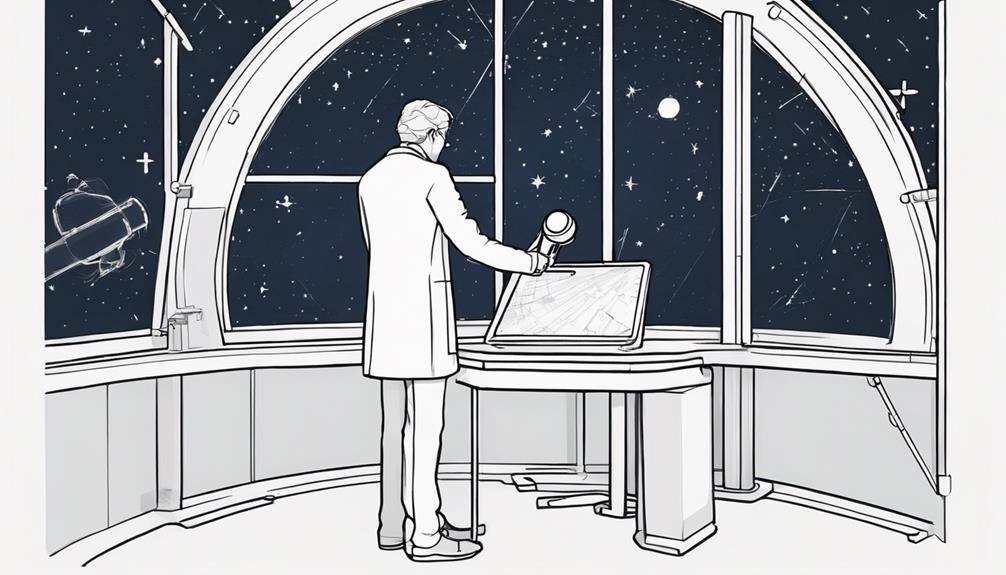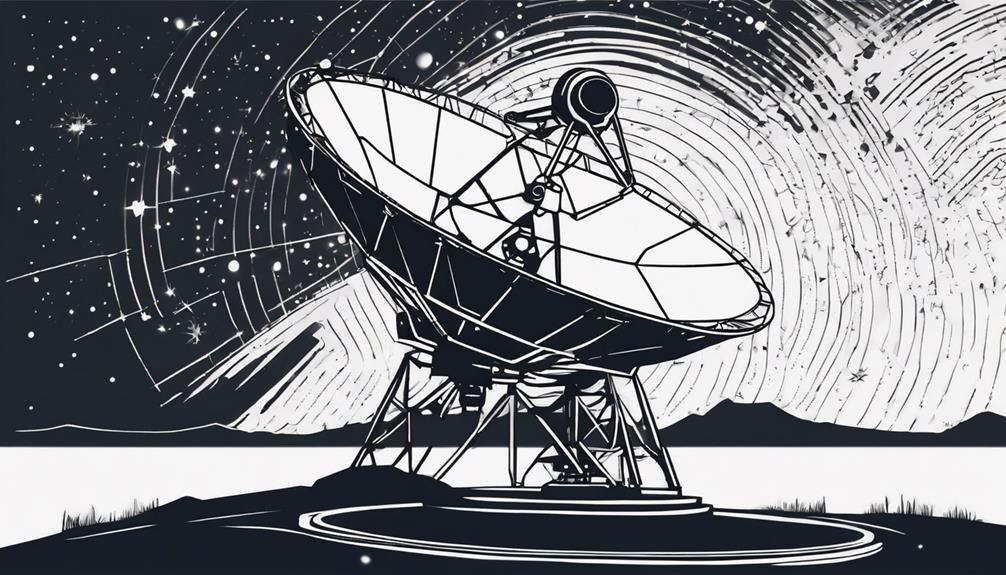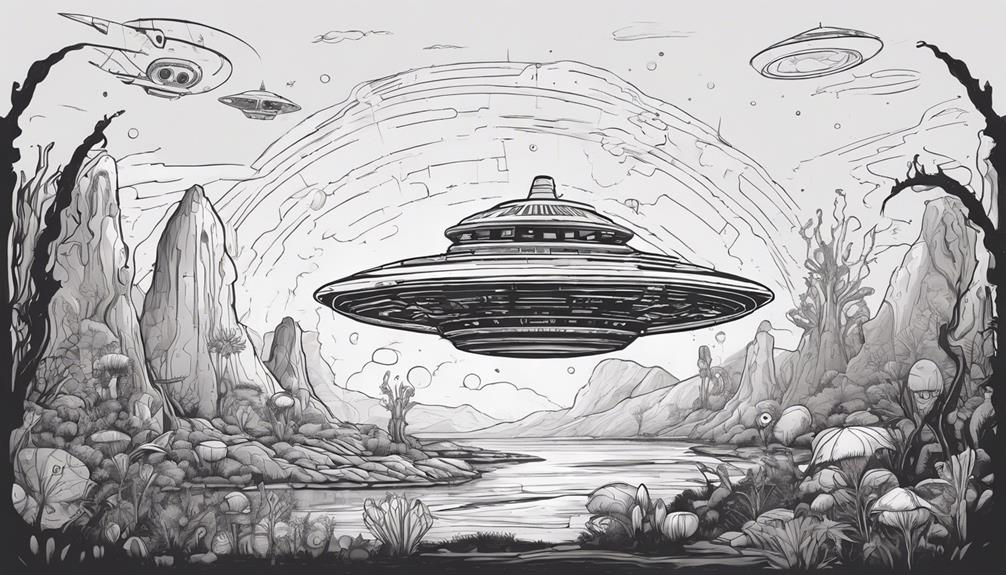Exploring the possibilities of extraterrestrial life involves a complex blend of scientific curiosity and skepticism. As researchers delve into the vastness of the cosmos, questions arise regarding the potential existence of life forms beyond our planet. The search for extraterrestrial life hinges on understanding the biochemical basis that could sustain alien organisms and identifying habitable environments in distant corners of the universe. With ongoing advancements in technology and space exploration, the quest to uncover extraterrestrial life remains a captivating enigma that continues to intrigue both scientists and the general public.
Key Takeaways
- Habitability factors determine the likelihood of alien life.
- Biochemical basis varies from Earth's processes.
- Mars, moons, and exoplanets offer potential habitats.
- Ongoing exploration and discoveries advance the search for extraterrestrial life.
Likelihood of Extraterrestrial Life

Analyzing the probability of extraterrestrial life presents a complex and speculative endeavor for scientists and researchers alike. NASA scientists are actively engaged in the search for extraterrestrial life, focusing on identifying habitable planets within and beyond our solar system. The presence of organic molecules, crucial for life as we know it, is a key aspect of their investigations.
The concept of planetary habitability plays a significant role in determining the likelihood of extraterrestrial life. Scientists consider whether the conditions on a particular planet could support life forms similar to those on Earth. This involves assessing factors such as the presence of water, a stable atmosphere, and a suitable temperature range.
While the vastness of the universe and the existence of consistent physical laws suggest that life may not be unique to Earth, debates persist regarding the uniqueness of our planet's conditions. The search for extraterrestrial life continues to be a challenging and thought-provoking area of scientific inquiry, with much yet to be discovered.
Biochemical Basis for Alien Life
Exploring the biochemical foundations of potential alien lifeforms demands a meticulous examination of the fundamental building blocks necessary for their existence. In considering the biochemical basis for alien life, several key points emerge:
- Water in a liquid state is essential for facilitating biochemical reactions in alien lifeforms, similar to its role in terrestrial biology.
- Silicon-based lifeforms, if they exist, would require specific environmental conditions to support their unique biochemistry, distinct from carbon-based life.
- Carbon and other elements, in conjunction with water, serve as the foundational elements enabling the formation and sustenance of potential alien life forms.
- Non-equilibrium thermodynamics, a concept crucial in understanding energy flow and transformation in living systems, likely plays a significant role in the biochemistry of extraterrestrial life.
As we delve into the possibility of alien biochemistries, it becomes evident that the biochemical processes governing potential extraterrestrial life may differ significantly from those observed on Earth, necessitating a broadened perspective and an open-minded approach to exploring the complexities of life beyond our planet.
Planetary Habitability Beyond Earth

Determining the habitability of celestial bodies beyond Earth requires a meticulous examination of various factors. The potential for alien habitats on Mars, moons hosting life, and the habitability of exoplanets are intriguing possibilities that warrant scientific scrutiny. Understanding the adaptability of life forms to diverse environments is crucial in assessing the likelihood of extraterrestrial life existing in the vast cosmos.
Alien Habitats on Mars
In the quest for understanding extraterrestrial habitats, the potential existence of alien habitats on Mars stands as a focal point of planetary habitability exploration beyond Earth.
- Evidence of ancient liquid water on Mars hints at past habitable conditions.
- Mars missions in the 21st century are actively investigating the planet's potential to sustain extraterrestrial life.
- Earth's extremophiles offer insights into the possibility of organisms surviving in Mars' harsh environment.
- The potential for native Martian organisms to exist, possibly below the surface, presents an exciting avenue for discovery through further exploration.
Mars, with its intriguing history of habitability and ongoing research efforts, remains a compelling candidate in the search for extraterrestrial life. The exploration of this red planet continues to captivate scientists and space enthusiasts alike.
Moons With Life
The potential for life beyond Earth extends to the intriguing possibility of habitable moons within our solar system, offering unique environments that challenge our understanding of the conditions necessary for extraterrestrial life. Moons like Europa, Enceladus, and Titan have shown promise in hosting life due to their subsurface oceans and presence of organic compounds. Europa's vast subsurface ocean, twice the volume of Earth's oceans, provides a potentially habitable environment for various life forms. Enceladus, with its geysers erupting from the south pole, indicates a subsurface ocean rich in essential elements for life. Titan, with its thick atmosphere and methane lakes, presents a unique environment where life might have evolved differently. These moons with subsurface oceans offer protected habitats and potential niches for extraterrestrial life forms to flourish.
Exoplanet Potential
Exploring the realm of exoplanet potential beyond Earth involves meticulous analysis of planetary habitability factors to discern the likelihood of sustaining extraterrestrial life forms.
Key Points:
- The habitable zone around stars plays a crucial role in assessing a planet's potential for supporting life.
- Scientists scrutinize exoplanet atmospheres to identify essential molecules that could signify habitability.
- Water, a fundamental element in the quest for extraterrestrial life, is a common indicator found where life thrives on Earth.
- Identifying planets within the habitable zone increases the chances of discovering moderate environments conducive to life.
Cutting-edge technology, such as advanced space telescopes and instruments, is in development to scrutinize exoplanet atmospheres for signs of habitability and potential life, pushing the boundaries of our understanding of life beyond our planet.
Scientific Search for Alien Life

Scientific endeavors to detect extraterrestrial life utilize advanced technologies and methodologies to explore the vast cosmos for potential signs of alien existence. The search for life beyond Earth involves various strategies, including the identification of exoplanets within the habitable zone of distant stars. Initiatives such as listening for extraterrestrial signals and studying planetary conditions aim to uncover conditions suitable for life as we know it. The Drake equation provides a framework for estimating the likelihood of intelligent civilizations in the universe, shaping the field of astrobiology.
With over 3,600 exoplanets discovered in 2,700 systems, scientists have a growing list of potential candidates for extraterrestrial habitats. International collaborations and robotic missions to explore our Solar System further expand the search for basic life forms. Astrobiology, a multidisciplinary field, plays a crucial role in investigating the origin, evolution, and distribution of life in the cosmos. Through these concerted efforts, scientists strive to unravel the mysteries surrounding the existence of alien life forms.
Search for Basic Life Forms
As scientists navigate the vastness of space in pursuit of basic life forms, the focus remains on the potential for microbial life existing in extreme environments. Explorations into planets within the habitable zone are driven by the fundamental search for conditions conducive to sustaining life beyond Earth. While the presence of essential elements like water and energy sources increases the prospects of discovering basic life forms, the absence of concrete evidence underscores the challenges of this scientific endeavor.
Microbial Life Potential
In the quest to uncover the potential for microbial life, researchers delve into the adaptability of basic life forms in extreme environments on Earth and beyond.
Key Points:
- Extremophiles on Earth showcase the resilience of microbial life in harsh conditions.
- Mars missions are focused on searching for traces of microbial life in ancient environments.
- Europa's subsurface ocean presents a promising habitat for microbial life exploration.
- Detection of microbial life, whether on Mars or Europa, would significantly contribute to understanding the prevalence of basic life forms in the universe.
Extreme Environments Exploration
Exploring the extreme environments of Earth and beyond offers valuable insights into the potential habitats for basic life forms in locations such as Mars, Europa, and other celestial bodies. Extremophiles on Earth have demonstrated the ability of basic life forms to survive in extreme conditions, hinting at the possibility of similar life forms existing elsewhere. These environments typically provide essential elements like liquid water and energy sources necessary for basic life forms to thrive. Scientists speculate that extremophiles from Earth could potentially adapt to survive on Mars, suggesting the presence of basic life forms on the red planet. The search for basic life forms extends to other celestial bodies like Europa and comets, where organic material and potential habitats may offer promising environments for the existence of basic life forms.
Search for Extraterrestrial Intelligences

Could the search for extraterrestrial intelligences be the key to unlocking the mysteries of the universe? Scientists have long been engaged in the exploration for signs of extraterrestrial intelligence, utilizing advanced tools and technologies like radio telescopes to scan the vast cosmos for any indications of alien civilizations. One of the most notable events in this quest was the detection of the Wow! signal in 1977, a strong narrowband radio signal that has puzzled researchers ever since.
Key Points:
- SETI Programs: Dedicated initiatives like SETI focus on detecting potential extraterrestrial signals amidst the cosmic noise.
- Radio Telescopes: These instruments play a crucial role in the search for extraterrestrial intelligence by capturing and analyzing radio emissions from space.
- Wow! Signal: The enigmatic Wow! signal, although not definitively proven to be of extraterrestrial origin, remains a captivating anomaly in the pursuit of alien intelligence.
- Technosignatures: Scientists are exploring the concept of technosignatures, which involves seeking traces of advanced alien technologies or artifacts in space.
The ongoing efforts to unravel the mysteries of extraterrestrial intelligence prompt profound questions about our place in the universe and the potential existence of other advanced civilizations.
Exploration of Extrasolar Planets
The exploration of extrasolar planets represents a critical frontier in scientific inquiry, expanding our understanding of planetary systems beyond our own while shedding light on the potential diversity of worlds that may harbor life. With over 5,000 exoplanets officially identified outside our solar system, scientists are particularly focused on planets within the habitable zone of stars, where conditions could support life as we know it. Advanced technology plays a crucial role in enhancing the search for exoplanets, intertwining the fields of astronomy and astrobiology. The hunt for exoplanets, a key aspect of astrobiology research, continues to yield exciting discoveries, with billions more planets awaiting identification.
| Keywords | Information |
|---|---|
| Planets around | Over 5,000 exoplanets have been officially identified. |
| Habitability | Scientists focus on planets within the habitable zone for potential life. |
| Astrobiology | Advanced technology enhances the search for exoplanets intertwined with astrobiology. |
| Exoplanet Discoveries | The hunt for exoplanets is a key aspect of astrobiology research. |
History of Cosmic Pluralism

Cosmic pluralism, tracing its origins to ancient Greek philosophy and evolving through the scientific paradigm shifts of subsequent centuries, has emerged as a pivotal concept in the exploration of extraterrestrial life possibilities. The historical development of cosmic pluralism can be outlined as follows:
- Ancient Greek Philosophers: Early thinkers like Anaximander and Democritus speculated on the existence of multiple worlds and diverse forms of life beyond Earth.
- Giordano Bruno (16th Century): Bruno's bold proposition of an infinite universe populated with numerous worlds and life forms challenged the prevailing geocentric cosmology of his time.
- Advancements in Astronomy: The 20th century witnessed significant progress in astronomy, leading to the discovery of exoplanets orbiting distant stars, which further fueled the concept of cosmic pluralism.
- Modern Scientific Exploration: Today, ongoing scientific endeavors continue to push the boundaries of our understanding, reinforcing the idea that the universe is vast and potentially teeming with diverse forms of extraterrestrial life.
Early Modern Views on Extraterrestrial Life
Emerging during the 16th and 17th centuries, early modern perspectives on extraterrestrial life presented a paradigm shift in philosophical and scientific discourse. Philosophers like Giordano Bruno and Johannes Kepler played pivotal roles in shaping these views. Kepler, known for his work on planetary motion, extrapolated his findings to suggest the existence of diverse inhabited worlds beyond Earth. Meanwhile, Bruno's cosmological ideas ventured even further, proposing an infinite universe teeming with countless inhabited planets. These bold assertions challenged the prevailing geocentric model and laid the groundwork for more nuanced discussions on the potential for extraterrestrial life.
| Thinker | Contribution | Influence |
|---|---|---|
| Giordano Bruno | Proposed an infinite universe with numerous inhabited planets, challenging traditional beliefs. | Expanded the scope of astronomical thought. |
| Johannes Kepler | Speculated on diverse inhabited worlds based on his studies of planetary motion. | Influenced later astronomers and thinkers. |
19th Century Perspectives

In the 20th century, scientific minds grappled with the possibility of extraterrestrial life through a lens of skepticism and rigorous inquiry. As astronomers and astrobiologists made significant strides in understanding the universe, debates on the existence of alien civilizations gained momentum. Technological advancements, particularly in radio telescopes, played a crucial role in the quest to detect potential extraterrestrial signals.
Historical Views
Dating back to ancient civilizations such as the Greeks and Egyptians, historical perspectives on extraterrestrial life have been a subject of contemplation and curiosity. In the 19th-century, advancements in science and astronomy fueled interest in the possibility of life beyond Earth. The development of telescopes allowed for closer examination of celestial bodies, leading to debates on Martian life due to the discovery of Mars' canals. This period saw early astronomers like Percival Lowell speculating on the existence of advanced civilizations on Mars. Additionally, the emergence of science fiction literature in the 19th and 20th centuries played a significant role in popularizing the concept of extraterrestrial life.
Scientific Discoveries
The historical speculation surrounding extraterrestrial life, particularly on Mars, has fueled scientific endeavors in the 20th century to uncover concrete evidence through a lens of skepticism and rigorous analysis. With the discovery of over 5,000 exoplanets, the search for extraterrestrial life has gained momentum. Europa's subsurface salty ocean and past liquid water on Mars offer potential habitats, while extremophiles thriving in extreme conditions on Earth showcase life's adaptability. Fossilized ancient Martian bacteria found in an Antarctic meteorite suggest Mars as a candidate for past extraterrestrial life. Theories also propose the possibility of life originating in cometary environments, broadening the scope of exobiology exploration. These scientific discoveries emphasize the need for continued exploration and investigation into the potential existence of extraterrestrial life forms.
Recent Cultural Impact on Extraterrestrial Life
Exploring the contemporary cultural landscape reveals a pervasive influence of extraterrestrial themes across various forms of media, shaping public perspectives on the potential existence of alien life. The recent cultural impact on extraterrestrial life can be understood through the following key points:
- Media Representation: Movies, TV shows, and literature frequently depict alien encounters and space exploration, contributing to a fascination with the idea of extraterrestrial beings.
- Public Perception: Pop culture references to extraterrestrial life play a significant role in shaping public beliefs about the existence of aliens, often blurring the lines between fact and fiction.
- UFO Phenomena: The ongoing interest in UFO sightings and alien abductions further fuels the cultural narrative surrounding extraterrestrial life, capturing the imagination of many.
- Symbolic Events: Events like the Roswell incident and the mystery surrounding Area 51 have become iconic symbols in popular culture, perpetuating intrigue and speculation about extraterrestrial mysteries.
The portrayal of aliens in media varies from friendly entities to menacing invaders, reflecting societal fears and curiosity about the unknown. This cultural backdrop influences how people perceive the possibilities of extraterrestrial life.
Extraterrestrial Life in Fiction

Extraterrestrial life in fiction presents a diverse array of imaginative depictions, ranging from benevolent beings to malevolent invaders, reflecting the boundless creativity and exploration of the human mind. Science fiction has long been a platform for authors and creators to explore the possibilities of life on other planets, often using extraterrestrial beings as a lens through which to examine humanity and societal issues. Works like 'War of the Worlds' and 'E.T. the Extra-Terrestrial' have ingrained varied perceptions of extraterrestrial life in popular culture. Influential authors such as H.G. Wells and Arthur C. Clarke have shaped the portrayal of extraterrestrial beings in literature and media, contributing to the ongoing fascination with the unknown.
Exploration, communication, and the enigmatic nature of the universe are common themes in extraterrestrial fiction. Through movies, TV shows, and books, audiences are continually captivated by the speculative scenarios of encountering extraterrestrial civilizations. While these depictions are imaginative and entertaining, they also reflect humanity's enduring curiosity about the vast cosmos and the potential for life beyond our own planet.
Government Responses to Alien Life
In light of the enduring intrigue surrounding the potential existence of extraterrestrial life, governmental entities worldwide have established protocols and initiatives to address the implications of potential encounters or communications with alien civilizations. This is crucial in ensuring a coordinated and rational approach to any potential contact with alien life forms. Here are key points regarding government responses to alien life:
- SETI Post-Detection Task Group: Governments have set up specialized groups like the SETI Post-Detection Task Group to coordinate responses to potential extraterrestrial signals, ensuring a systematic and organized approach to analyzing any detected transmissions.
- United Nations Office for Outer Space Affairs: The United Nations Office for Outer Space Affairs could play a pivotal role in coordinating international responses to alien life, promoting collaboration and information sharing among nations.
- UFO Sightings and Secrecy: Some governments have classified information related to UFO sightings, leading to secrecy and speculation, highlighting the need for transparency in dealing with such phenomena.
- Project Blue Book and International Cooperation: Programs like Project Blue Book in the U.S. have investigated UFO sightings, emphasizing the importance of international cooperation and sharing findings to formulate responsible and unified responses to potential contact with alien life.
The Future of Discovering Extraterrestrial Life

The quest for identifying potential extraterrestrial life forms continues to drive scientific exploration and technological advancements. Future space missions, particularly those focused on Mars exploration like the European Space Agency's Mars Express, are designed to search for evidence of past or present life on the red planet. The Aurora Programme's plans for sample return missions and potential human visits to Mars aim to deepen our understanding of the planet's habitability and potential for hosting life.
Exobiologists, not limited to planetary environments, are turning their attention to cometary environments in the search for extraterrestrial life. The theory that life could have originated in comets and later spread to planets has prompted investigations into comets known to contain organic material.
With ongoing advancements in technology and increased international collaborations, the prospects of discovering extraterrestrial life in the near future are more promising than ever before. By leveraging these tools and exploring diverse environments beyond Earth, scientists are inching closer to potentially uncovering evidence of life beyond our own planet.
Frequently Asked Questions
Is It Possible for There to Be Life on Other Planets?
The search for life beyond Earth remains a fundamental question in astrobiological research. While the concept of alien civilizations captures our imagination, scientific evidence regarding potential habitats for microbial life on other planets is limited. Identifying exoplanets with Earth-like conditions is crucial. Advanced technology is being developed to analyze exoplanet atmospheres for signs of life. The possibilities of extraterrestrial life continue to intrigue scientists, but concrete evidence remains elusive.
Is There a Possibility That There Are Other Planets That Are Habitable Aside From Earth?
Currently, the exploration of exoplanets has revealed several candidates within habitable zones, suggesting the potential for habitable worlds beyond Earth. However, while these discoveries are promising, the existence of habitable exoplanets does not guarantee the presence of alien civilizations. Further research in astrobiology, exoplanet discoveries, and advancements in interstellar travel are necessary to confirm the possibilities of extraterrestrial life.
What Are Extraterrestrial Resources?
Extraterrestrial resources encompass a wide array of materials and energy sources found beyond Earth. These resources are pivotal for future endeavors in alien technology, resource mining, space colonization, energy sources, and planetary exploration. Scientific exploration missions are crucial in identifying and assessing the viability of these extraterrestrial resources. Utilizing such resources could revolutionize human space activities and pave the way for sustainable endeavors in the vast expanse of space.
Which Planet Can Have Life Other Than Earth?
When considering potential habitats for extraterrestrial life beyond Earth, Mars stands out due to past evidence of liquid water. Europa, a moon of Jupiter, is another candidate with its subsurface ocean. Both locations possess conditions that could support microbial life. Exploring atmospheric conditions and extreme environments on these celestial bodies may provide insights into the existence of life forms beyond our planet. Investigating these possibilities scientifically is crucial for understanding the potential for extraterrestrial life.
Conclusion
In the vast expanse of the universe, the possibilities of extraterrestrial life remain a tantalizing mystery. While scientific exploration continues to search for signs of alien existence, the ultimate truth eludes us. As we ponder the vastness of space and the complexities of life on Earth, the enigma of extraterrestrial life persists, beckoning us to delve deeper into the unknown realms of the cosmos.
